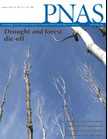PNAS:阎锡蕴等揭示CD146分子促进乳腺癌进展新机制
2012-01-06 MedSci原创 MedSci原创
近日,国际著名杂志《美国国家科学院院刊》PNAS在线发表中国科学院生物物理研究所阎锡蕴课题组的最新研究成果“CD146, a epithelial-mesenchymal transition inducer, is associated with triple-negative breast cancer。”,文章中,该项研究首次报道细胞黏附分子CD146促进乳腺癌进展的新机制。 阎锡蕴课
近日,国际著名杂志《美国国家科学院院刊》PNAS在线发表中国科学院生物物理研究所阎锡蕴课题组的最新研究成果“CD146, a epithelial-mesenchymal transition inducer, is associated with triple-negative breast cancer。”,文章中,该项研究首次报道细胞黏附分子CD146促进乳腺癌进展的新机制。
阎锡蕴课题组发现,CD146分子在上皮性质的乳腺癌细胞中过表达将导致细胞发生上皮-间叶转化(Epithelial-Mesenchymal Transition, EMT),从而是原本恶性程度较低的肿瘤细胞获得极高的细胞侵袭迁移能力,以及乳腺癌干细胞的特征。CD146高表达的乳腺癌肿瘤细胞在SCID小鼠内更容易形成分化程度低的肿瘤,迅速侵袭到周围正常组织,并转移到肺、肝脏等重要脏器。
同时,他们发现小G蛋白RhoA的激活及转录因子Slug的表达上调在CD146诱导EMT的过程中发挥关键作用。更重要的是,通过对505例乳腺癌肿瘤组织检测发现,CD146的表达与肿瘤分级及预后相关。CD146在临床上致死率最高、最容易发生复发转移的三阴性乳腺癌中高表达,并与E- cadherin的表达呈负相关。
这些结果表明CD146通过EMT的机制促进乳腺癌进展,因此CD146可能作为治疗乳腺癌的一个新靶标,尤其针对三阴性乳腺癌。
该项研究得到科技部、自然科学基金委和中国科学院的资助。(生物谷Bioon.com)
CD146, an epithelial-mesenchymal transition inducer, is associated with triple-negative breast cancer
Qiqun Zenga,1, Weidong Lib,1, Di Lua, Zhenzhen Wua, Hongxia Duana, Yongting Luoa, Jing Fenga, Dongling Yanga, Li Fub,2, and Xiyun Yana,2
The epithelial-mesenchymal transition (EMT) plays an important role in breast cancer metastasis, especially in the most aggressive and lethal subtype, “triple-negative breast cancer” (TNBC). Here, we report that CD146 is a unique activator of EMTs and significantly correlates with TNBC. In epithelial breast cancer cells, overexpression of CD146 down-regulated epithelial markers and up-regulated mesenchymal markers, significantly promoted cell migration and invasion, and induced cancer stem cell-like properties. We further found that RhoA pathways positively regulated CD146-induced EMTs via the key EMT transcriptional factor Slug. An orthotopic breast tumor model demonstrated that CD146-overexpressing breast tumors showed a poorly differentiated phenotype and displayed increased tumor invasion and metastasis. We confirmed these findings by conducting an immunohistochemical analysis of 505 human primary breast tumor tissues and found that CD146 expression was significantly associated with high tumor stage, poor prognosis, and TNBC. CD146 was expressed at abnormally high levels (68.9%), and was strongly associated with E-cadherin down-regulation in TNBC samples. Taken together, these findings provide unique evidence that CD146 promotes breast cancer progression by induction of EMTs via the activation of RhoA and up-regulation of Slug. Thus, CD146 could be a therapeutic target for breast cancer, especially for TNBC.
本网站所有内容来源注明为“梅斯医学”或“MedSci原创”的文字、图片和音视频资料,版权均属于梅斯医学所有。非经授权,任何媒体、网站或个人不得转载,授权转载时须注明来源为“梅斯医学”。其它来源的文章系转载文章,或“梅斯号”自媒体发布的文章,仅系出于传递更多信息之目的,本站仅负责审核内容合规,其内容不代表本站立场,本站不负责内容的准确性和版权。如果存在侵权、或不希望被转载的媒体或个人可与我们联系,我们将立即进行删除处理。
在此留言








#CD146#
68
#CD14#
80
#PNAS#
86